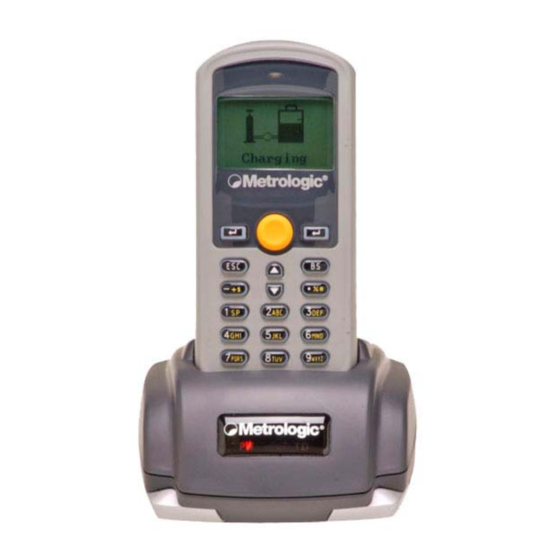Table of Contents
Advertisement
Advertisement
Table of Contents

Summary of Contents for Metrologic SP5500
- Page 1 Metrologic Instruments, Inc. SP5500 Optimus S Series Users’s Guide...
- Page 2 Copyright © 2005 by Metrologic Instruments, Inc. All rights reserved. No part of this work may be reproduced, transmitted, or stored in any form or by any means without prior written consent, except by reviewer, who may quote brief passages in a review, or provided for in the Copyright Act of 1976.
-
Page 3: Table Of Contents
Table of Contents Cover Page................................i Introduction ................................4 Product Overview............................4 Scanner and Accessories ..........................5 General Features and Characteristics........................ 6 Multifunctional Keypad..........................7 The LCD Screen............................8 The Lithium-Ion Battery ..........................8 Installation................................9 Getting Started.............................. 9 Basic Operation*............................ -
Page 4: Introduction
Introduction Product Overview The SP5500 Optimus S Portable Data Terminals are robust and versatile data terminals designed to provide exceptional performance, while enduring the demands of everyday use. The lithium-ion rechargeable battery provides the Optimus with more than 100 hours of operation. It is supported by a resourceful set of development tools. -
Page 5: Scanner And Accessories
Scanner and Accessories ETROLOGIC UMBERS ESCRIPTION SP5501-6 OptimusS laser batch unit with 1MB RAM SP5502-6 OptimusS laser batch unit with 2MB RAM SP5535-6 OptimusS laser Bluetooth unit MI5500-614 OptimusS Charging/Communication cradle... -
Page 6: General Features And Characteristics
General Features and Characteristics Figure 1. Scanner Features Figure 3 Product Label ESCRIPTION Red Output Window (Laser Aperture) Safety and Product label (Figure 3) Speaker for audible indicators LCD display Multi-functional Keypad Charging and communication contacts IrDA Communication port Battery Compartment release Scan Button Figure 4 Optimus and Cradle Figure .2.Cradle Features... -
Page 7: Multifunctional Keypad
Multifunctional Keypad Figure 5.Cradle Features ESCRIPTION Power On/Off. POWER To prevent a faulty push, it needs about 1.5 sec of continuous pressing to turn On/Off the power. Alphanumeric ALPHANUMERIC These 10 keys can be used for either alpha characters or numerical input. (See Item 8 for further description of key operation) Enter. -
Page 8: The Lcd Screen
ESCRIPTION The toggle key for Alphabet / Numeral input. When the system is in alpha-mode, a small icon will be shown in the lower right corner of the display. For the 24-key keyboard, each numeric key can be used to generate one of the three capital letters located on that number key. -
Page 9: Installation
Installation Getting Started The Optimus S Portable Data Terminal (PDT) requires minimal effort to begin functional operation for data collection in any application. In order to get started the unit must have a fresh battery inserted into the battery compartment. 1. -
Page 10: Basic Operation
Basic Operation In order for the Optimus to operate properly, an application program must be loaded onto the PDT. If upon power up the Optimus has no application program loaded, then the following Application Manger menu options will appear on the display: PTIONS ESCRIPTION This option allows the user to download application programs (*.SHX), BASIC run-time... - Page 11 3. For the USB cable plug the USB end of the cable into an appropriate communication port on the host device and the opposite end of the cable into the communication port of the cradle. 4. Power up the Optimus and select the Utlities option. 5.
-
Page 12: System Settings And Operation Tests
System Settings and Operation Tests Depending on the application program that is active on the Optimus, there are number of settings and options that may be selected for both setup and testing. The table shows a number of those settings and their descriptions. -
Page 13: Application
• The Optimizer • The “BASIC” Compiler • The “C” Compiler For detailed information, please contact Metrologic Instruments, Inc.. Programming the communication cradle The communication cradle of the Optimus S Portable Data Terminal supports serial IR interface only. If a customized PC application has been developed for communication with the terminal via the cradle, it will be necessary to first configure the cradle through programming. -
Page 14: Troubleshooting
Troubleshooting YMPTOM ESCRIPTION Make sure the battery is loaded. Charge the battery and check the charging status. If no charging information shown on Does not power up after the display, reload the battery and check if the battery is properly installed then try pressing POWER key. -
Page 15: Specification
Specification PTIMUS ERIES PERATIONAL Light Source: Visible Laser Diode (VLD) @ 650 nm 20 mm - 202 mm 0.33 mm (13 mil) Normal Depth of Field: (.75"- 8.75") bar code Width of Scan Field: 290mm (11.4”) @ 222 mm (8.75”) Single-Line Scan Speed: 100 scan lines per second... -
Page 16: Optimuss Series
PTIMUS ERIES ECHANICAL Width (Unit): 55 mm (2.2") Depth (Unit): 28 mm (1.1") Height (Unit): 137 mm (5.4") Weight (Unit): 4.9 oz (140 g) – including battery Width (Cradle): 92 mm (3.6") Depth (Cradle): 110 mm (4.3") Height (Cradle): 58 mm (2.3") LECTRICAL Battery Operation: Li-ion... -
Page 17: Contact Information And Office Locations
Tel: +34 913 272 400 Fax: +34 913 273 829 Email: info@es.metrologic.com Metro (Suzhou) Sales Office Tel: 86-512-67622550 Fax: 86-512-67622560 Metrologic European Repair Center (MERC) Email: info@cn.metrologic.com Metrologic Eria Ibérica, SL Tel: +34 913 751 249 Fax: +34 913 270 437... -
Page 18: Safety Notices
Safety Notices This equipment has been tested and found to comply with the limits for a Class B digital device, pursuant to Part 15 of the FCC Rules. These limits are designed to provide reasonable protection against harmful interference in a residential installation. This equipment generates, uses and can radiate radio frequency energy and, if not installed and used in accordance with the instructions, may cause harmful interference to radio communications.



Need help?
Do you have a question about the SP5500 and is the answer not in the manual?
Questions and answers